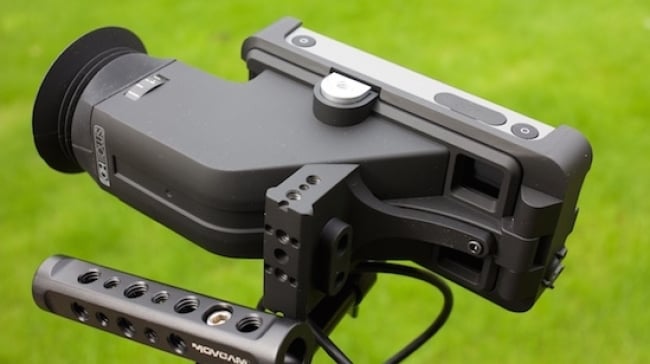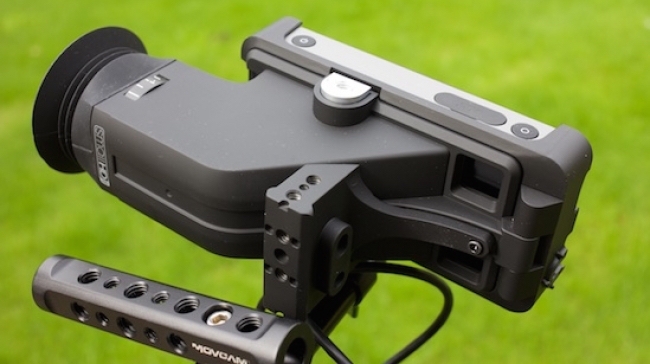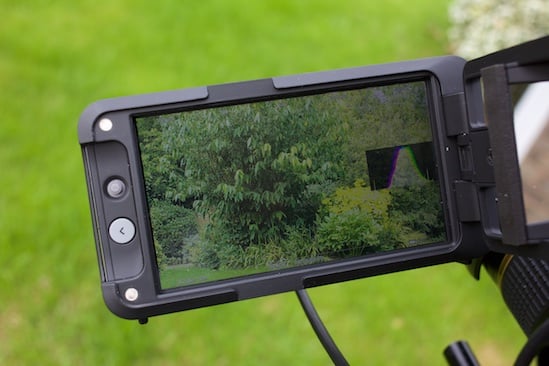
 SmallHD 502 and Sidefinder
SmallHD 502 and Sidefinder
Simon Wyndham looks at the 502 field monitor and Sidefinder EVF-attachment, an innovative new system from SmallHD.
The humble viewfinder. It is a piece of equipment that, at one time, would be taken for granted. You purchased a camera and you could pretty much guarantee that it would have one. In many instances now, the viewfinder has become an optional extra. Cameras such as the Blackmagic range do not come with them, although the company has addressed this with a new optional viewfinder for the URSA range.
There are a number of third party options currently available on the market, but there is one company who has decided to enter the fray with an innovative new monitor/viewfinder. The company is SmallHD and it has been producing on set monitoring solutions for a number of years now. But, until now, it has not produced a highly compact on-camera viewfinder solution.
With the introduction of the 5-inch 502 monitor, all this has changed. The 502, as a base unit, is a high quality LCD designed for on-camera mounting. However, with the addition of the optional Sidefinder unit, it becomes a fully integrated viewfinder solution.
What’s in the box?
SmallHD supplied me with the Production pack, which includes not only the monitor and Sidefinder, but various clamps and a 15mm rod to ensure that you can mount the system conveniently onto most cameras. Two Canon-style E6 batteries, cleaning cloths and a protective sleeve are also included. Connectivity hasn’t been forgotten, either, with multiple SDI and HDMI cable variants thrown-in as well. The Production pack stows away in a sturdy hard plastic case for easy transportation and protection.
First Impressions
What is immediately apparent after taking the 502 out of the box is just how nicely built it is. It isn’t heavy, but it has a nice weight to it, with the build quality being exceptional. There are multiple mounting points on the sides of the device to enable a number of different mounting configurations.
The rear of the device contains two Canon style E6 mounting points to allow two batteries to be fitted simultaneously, along with SDI in and out and full size HDMI in and out. The top of the monitor is reserved for the power switch and an SD card slot which is used for loading LUTs, as well as performing firmware updates.
On the left hand side of the screen itself, you can find the main menu navigation controls, consisting of a small clickable joystick and a 'back' button.
So far, so straightforward. I mounted the monitor onto my BMPCC via the excellent Movcam cage system. I opted to mount it directly to the 15mm rod in a classical viewfinder position. This made for a fairly compact system. If you need an even lighter setup, you could remove the Sidefinder system and mount it as a straight monitor with a sunshade if required.
Pages and...Pong?!

When I first turned on the 502 to set it up, one of the first things I was greeted with was a game of Pong! It seems the people at SmallHD have a sense of humour, but it also shows the attention to detail they have gone to. A nice touch!
In use, the 502 allows for several different workspaces, what SmallHD have termed Pages, to be set up. This means that you can save a number of preferred configurations. Any of these can be modified at any time. Options include waveform and histogram displays, audio meters with dbfs scale, coloured focus assist, peaking, frame guides, false colour exposure assist and more. Each of these can be fully customised as to their size, position on the screen and opacity.
The Pages system comes in useful in this regard, since you can set up spaces that have waveforms, one that has audio meters and so on, rather than crowding one screen with all of them and having to manually switch them on and off all the time. This system is also useful if you want to try different LUTs on different pages for straightforward easy comparisons. These pages can be switched quickly with a simple click left-or-right on the joystick.
The brightness and native 1920x1080 resolution of the screen in use is exceptional, offering a density 441 pixels per inch. For the sake of comparison the iPhone 6 Plus, which has a screen half an inch larger than the 502 at the same resolution, offers a density of 401 pixels per inch.
Clearly, the Sidefinder loupe attachment comes into its own on bright sunny days. When you just want to use the monitor itself without the loupe, it can be flipped out to the side. To clarify this, the monitor itself that hinges outwards, as opposed to the setup many of us have used (i.e. a loupe that flips up).
Booting up the monitor is very fast, taking only a couple of seconds or so. Making my way through the menu screens was a cinch with the little joystick control. I am glad that SmallHD opted for this rather than a touch screen system, which would have resulted in grubby fingerprints all over it. Pressing the joystick up when viewing the picture results in the Pixel Zoom feature being activated, which allows for fast critical viewing and panning over the image for focus checking.
Conclusions
There are quite a number of viewfinder solutions available on the market, including the pricey Zacuto Gratical HD system. However, while many of them are competing for a slightly different market and most of them do not have the versatility of the SmallHD 502 system, when combined with the Sidefinder, because those products are dedicated viewfinders with fixed loupes.
The SmallHD 502, when running on two Canon E6 batteries, is a highly useful and versatile system with long run-times and a surprising ease of use when the number of complex features is factored in. It can be used as a full on viewfinder or as a straightforward traditional camera mounted monitor display.
If you are looking for an on-camera monitoring solution that is highly portable and adaptable, yet offers very little to no compromise in image quality, then the SmallHD 502 should find a place in your list of contenders. Frankly, I think it is a fantastic little device.
Tags: Production


Comments